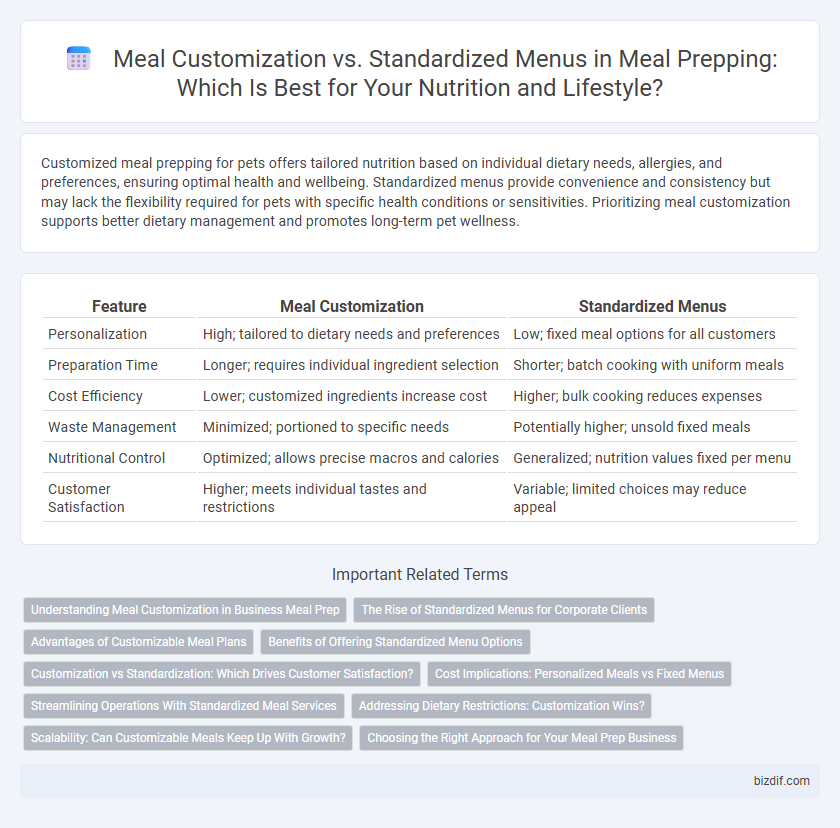Customized meal prepping for pets offers tailored nutrition based on individual dietary needs, allergies, and preferences, ensuring optimal health and wellbeing. Standardized menus provide convenience and consistency but may lack the flexibility required for pets with specific health conditions or sensitivities. Prioritizing meal customization supports better dietary management and promotes long-term pet wellness.
Table of Comparison
| Feature | Meal Customization | Standardized Menus |
|---|---|---|
| Personalization | High; tailored to dietary needs and preferences | Low; fixed meal options for all customers |
| Preparation Time | Longer; requires individual ingredient selection | Shorter; batch cooking with uniform meals |
| Cost Efficiency | Lower; customized ingredients increase cost | Higher; bulk cooking reduces expenses |
| Waste Management | Minimized; portioned to specific needs | Potentially higher; unsold fixed meals |
| Nutritional Control | Optimized; allows precise macros and calories | Generalized; nutrition values fixed per menu |
| Customer Satisfaction | Higher; meets individual tastes and restrictions | Variable; limited choices may reduce appeal |
Understanding Meal Customization in Business Meal Prep
Understanding meal customization in business meal prep involves tailoring dishes to meet individual dietary preferences, nutritional needs, and flavor profiles, enhancing customer satisfaction and loyalty. Customized meals enable companies to accommodate allergies, lifestyle choices such as veganism or keto, and specific calorie requirements, ensuring a more personalized dining experience. This flexibility contrasts with standardized menus by offering greater variety and adaptability, which can lead to increased market competitiveness and client retention.
The Rise of Standardized Menus for Corporate Clients
Standardized menus have seen significant growth in corporate meal prepping due to their efficiency and consistency in meeting nutritional guidelines and dietary restrictions. Large corporations prefer standardized menus as they streamline ordering processes, reduce food waste, and ensure uniform quality across multiple locations. These menus also simplify calorie tracking and compliance with wellness programs, making them an ideal choice for corporate clients aiming to promote employee health.
Advantages of Customizable Meal Plans
Customizable meal plans offer significant advantages by catering to individual dietary needs and personal taste preferences, enhancing nutritional balance and satisfaction. They allow precise control over ingredient selection, portion sizes, and allergen management, reducing food waste and promoting healthier eating habits. This flexibility supports diverse lifestyles and goals, from weight management to muscle gain, making meal prepping more effective and enjoyable.
Benefits of Offering Standardized Menu Options
Standardized menu options streamline meal prepping by ensuring consistent portion sizes and nutritional balance, reducing preparation time and minimizing food waste. These options simplify ordering and inventory management, enhancing operational efficiency for meal service providers. Customers benefit from reliable taste and quality, promoting satisfaction and repeat business.
Customization vs Standardization: Which Drives Customer Satisfaction?
Meal customization enhances customer satisfaction by addressing individual dietary preferences, allergies, and flavor profiles, leading to a personalized dining experience. Standardized menus streamline operations and ensure consistency but may limit options for diverse nutritional needs. Studies reveal that businesses offering customizable meal prep options tend to see higher repeat customers and positive reviews due to tailored meal experiences.
Cost Implications: Personalized Meals vs Fixed Menus
Personalized meals in meal prepping often lead to higher costs due to varied ingredient sourcing, increased labor, and packaging complexity. Standardized menus benefit from bulk purchasing and streamlined preparation, reducing overall expenses and improving cost-efficiency. Businesses must balance customization demand with budget constraints to optimize profitability and customer satisfaction.
Streamlining Operations With Standardized Meal Services
Standardized meal services streamline operations by reducing preparation time, minimizing inventory complexity, and ensuring consistent portion control across all meals. This approach enhances efficiency in commercial kitchens by enabling batch cooking and simplified training for staff. Optimizing ingredient usage through standardized menus also lowers food waste and cuts overall costs, making it ideal for high-volume meal distribution.
Addressing Dietary Restrictions: Customization Wins?
Meal customization excels in addressing dietary restrictions by allowing individuals to select ingredients tailored to allergies, intolerances, and nutritional needs, ensuring safer and more satisfying meals. Unlike standardized menus, which often rely on broad categories and fixed recipes, customized meal prepping minimizes the risk of cross-contamination and nutrient imbalances. Personalized meal plans enhance dietary adherence and improve health outcomes by offering flexibility that standardized menus typically lack.
Scalability: Can Customizable Meals Keep Up With Growth?
Customizable meals offer personalized nutrition but pose challenges for scalability due to increased complexity in inventory management, preparation time, and delivery logistics. Standardized menus streamline operations, enabling consistent quality and faster service, which supports higher volume growth more efficiently. Balancing customization with scalable systems requires advanced technology solutions like AI-driven order management and modular meal components.
Choosing the Right Approach for Your Meal Prep Business
Meal customization offers personalized options that cater to diverse dietary preferences, boosting customer satisfaction and loyalty in meal prep businesses. Standardized menus streamline operations, reduce costs, and ensure consistent quality, making them ideal for scaling and efficiency. Evaluating target market demands and operational capabilities helps determine whether a flexible, tailored approach or a streamlined, uniform menu best supports business growth.
Meal customization vs standardized menus Infographic

 bizdif.com
bizdif.com